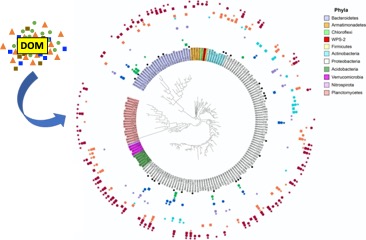Wu, X.; S.J. Spencer, S. Gushgari-Doyle, M.O. Yee, J. Voriskova, Y. li, E.J. Alm, R. Chakraborty (2020) Culturing of ‘Unculturable’ Subsurface Microbes: Natural Organic Carbon Source Fuels the Growth of Diverse and Distinct Bacteria from Groundwater. Front. Microbiol [doi]:3389/fmicb.2020.610001OSTI:1756120
An effective cultivation and isolation strategy using natural complex carbon source recovers diverse and novel bacteria from the terrestrial subsurface.

The Science
Despite rapid technological advances in modern molecular tools for identification of key microbial taxa and critical metabolic processes in a given environment, a complete interpretation of omics-based data is still constrained by the unavailability of reference genomes and physiologically characterized isolates. Challenges in microbial cultivation/isolation in the laboratory have impeded the ability of microbiologists to fully investigate the roles and function of microbes in terrestrial subsurface ecosystems. To date scientists have only been able to cultivate less than 2% of microbes on Earth in the laboratory.
The Impact
Obtaining axenic representatives of “once-unculturable” microorganisms will enhance our understanding of microbial physiology and function in different biogeochemical niches of terrestrial subsurface ecosystems. In this study, we developed an effective cultivation and isolation strategy using natural complex carbon source to recover diverse bacteria, including candidate novel, rarely cultivated, and undescribed organisms from the terrestrial subsurface. Our cultivation strategy will benefit future development of effective and ecologically relevant cultivation/isolation strategies. These improved capabilities will be crucial for further understanding of bacterial physiology, functions, and roles in biogeochemical cycles in terrestrial subsurface ecosystems.
Summary
Here we applied complex carbon sources, i.e., sediment dissolved organic matter and bacterial cell lysate, to enrich groundwater microbial communities. As comparisons, we also included enrichments amended with simple carbon sources including glucose, acetate, benzoate, oleic acid, cellulose, and mixed vitamins. Our results demonstrate that complex carbon is far more effective in enriching diverse and distinct microorganisms from groundwater than simple carbon. Simple carbon enrichments yield significantly lower biodiversity, and are dominated by few phyla (e.g., Proteobacteria and Bacteroidetes), while microcosms enriched with complex carbon demonstrate significantly higher biodiversity including phyla that are poorly represented in published culture collections (e.g., Verrucomicrobia, Planctomycetes, and Armatimonadetes). Subsequent isolation from complex carbon enrichments yielded 228 bacterial isolates representing 5 phyla, 17 orders, and 56 distinct species, including candidate novel, rarely cultivated, and undescribed organisms.
Also highlighted https://eesa.lbl.gov/study-finds-natural-organic-carbon-source-fuels-growth-of-diverse-distinct-bacteria-from-groundwater/
Contact
Romy Chakraborty
Department of Ecology, Earth and Environmental Sciences Area,
Lawrence Berkeley National Laboratory,
Berkeley, CA, United States
rchakraborty@lbl.gov
Xiaoqin Wu
Department of Ecology, Earth and Environmental Sciences Area,
Lawrence Berkeley National Laboratory,
Berkeley, CA, United States
